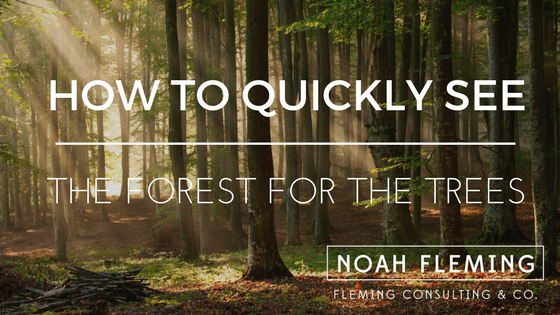Last year, I started writing quite a bit about the Pick-3 process, an intervention that I bring to almost every one of my clients with great success. Since sharing the details of the Pick-3 process, I’ve received hundreds of emails from companies around the world telling me about how they’re using and adapting it to stay in better contact with their clients, and I’ve heard some incredible success stories from it. From the ones I’ve worked with personally, we’ve had even greater results.
This week, I want to introduce another tool from the Evergreen toolkit that’s had a huge impact on companies where I’ve introduced it. I call this one the “Evergreen Forest.” Much like the Pick-3, there is a tremendous value to using it even in its simplest forms, and we have developed more powerful and sophisticated versions of it for our use in client engagements.
Here’s the basic version of the Evergreen Forest (as seen in the image below), in just three steps:
Step 1: List all of your products and services vertically;
Step 2: List all of your customers across the horizontal axis
Step 3: Put a tree in any square where you have sold that product or service, to that client; If you haven’t sold that product to that client, put a watering pail.
(These are the instructions for the “give it a try at home, kids!” version. We’ve crafted a much more powerful tool for companies that involves looking at every sale to every customer, multiple criteria for what gets a tree vs. watering pail, and many other features that make it more applicable for day-to-day use. That being said, this is still an incredibly powerful exercise to go through even with just the three steps above!)
This gives us an instant, visual representation of where our forests are lush and vibrant–represented by which customers have purchased what. Often, more importantly, it also shows exactly where we’re in lacking and what opportunities exist with which customers.
Let’s look at how we’d use this information:
As we can see here, customer #1 is currently buying all of our products and services that we offer. This is fantastic, and it shows us that Customer 1 is really a “True Believer!”
But we can also see that customer #4 has only purchased one of products or services. This might be because they’re a new customer–or it might represent a bigger opportunity–we won’t know until we dig deeper, but without a simple visual these opportunities might be hard to define.
Even in companies with very sophisticated ERPs and sales/CRM systems, we’ve watched Sales and Marketing managers struggle to find and create these types of opportunities for their people.
We’ve seen other clients doing it manually with excel sheets, but we’ve found the visual representation with the ability to drill down–even if we’re talking about thousands of customers and products–being an insanely powerful growth tool. The other cool thing about our tool is we can equip every sales person in your organization with it, and they instantly see which opportunities they should be exploiting and where they might be falling short.
Think of the other uses here as well. For example, we can define criteria and find products and services that are underperforming. For example:
A hospitality business might decide to jettison specific menu items based on forest growth.
A retail company might find customers who need more of a personal touch, and the customers are instantly identifiable.
A manufacturer might see huge opportunities growth. This works remarkably well when we’re comparing ancillary products right next to each other. For example, we might quickly see that most clients who buy products 3 and four almost always way products 5 and 6. With the forest, we instantly find these opportunities.
A multi-brand retailer with distributors and resellers might look at which resellers are carrying which of your brands, and which ones they aren’t.
Finally, it can also help you curb attrition much more effectively. I’ve often written that the core challenge with attrition is determining when you’ve “lost” a client. By limiting the Evergreen Forest to look at purchases over a certain time frame, you can see which clients haven’t purchased from you in all the areas you’d expect, and have your sales team contact them to find out why. (This is also useful for companies with only one core product or service)
Simple.
Your Weekly Challenge:
Spend some time today with your sales manager or top people and create your own version of the forest. Or think about your top 3-5 customers and which of your products and services they’ve bought, and which ones they haven’t.
Download a blank PDF copy of the forest HERE. Put a few products and services (or, if you have more than a few dozen, then put the product categories instead) on the left and a few customers and clients along the bottom. Review your sales/marketing data and see if you can quickly spot an opportunity for growth.
The next part of the challenge is simple – do something with what you learn.
Send me an email to let me know two very specific things.
1) What have you learned that you didn’t know before the exercise?
2) what steps you’re taking with that information?

